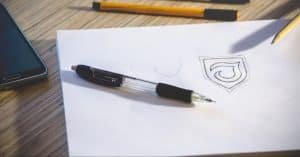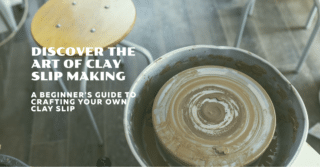If you’re a ceramics enthusiast seeking to expand your creative repertoire or a curious beginner eager to try your hand at some ancient techniques, you’ve come to the right place. In this comprehensive guide, we’ll unveil 10 must-have tools that are sure to elevate your coil building and pinching endeavors to new heights. From shaping delicate vessels to sculpting intricate designs, these essential tools will quickly become your trusted studio companions.
Banding wheel

An invaluable tool no matter what your making method, banding wheels are particularly useful for the coil builder. They allow you to smoothly rotate your piece with minimal effort, making attaching each coil a fluid experience. They come in a variety of heights and diameters, so you’ll be able to find one to suit your needs whatever size you prefer to work at. They’re also available in a number of materials, but we recommend investing in a metal one, as they tend to have a more stable spin, can handle heavy work, and are built to last a lifetime.
Burnishing Tools – Stones and Spoons

channel=AndyWard%27sAncientPottery
While burnishing can be achieved with any making method, it’s particularly loved by coil-builders, perhaps due to the ancient connection between the two methods. Burnishing is a process of compressing the clay surface, aligning the clay particles so that they create a beautifully lustrous and less porous surface. Achieving a burnished surface is a labor-intensive process, but luckily its tools are affordable, or even free! Most commonly used are the bowl of a metal spoon, or a smooth beach stone. So take a day to go beachcombing, and select a few stones to try out. You’ll quickly find what shapes you prefer, and what size is most comfortable for you to hold for long periods. And if there aren’t any beaches nearby, simply raid your kitchen for the perfect metal spoon!
Stamps and Texturizers

-symbol-knot-stamps-26mm?_pos=11&_fid=95856a522&_ss=c
Coiled surfaces make excellent canvases for texture and pattern, so it’s handy to have a collection of stamps and texturizers available. Many pottery suppliers have stamp collections available, but to really push the uniqueness of your pieces, try making some of your own as well! And be sure to explore your home and environment for potential texture makers such as fabric and tree bark. Once you start thinking this way, you’ll see potential stamps everywhere!
Paddle

clay-paddle-large/
Sometimes we need to help our coiled forms into the shape we need, and wooden paddles are a great tool for exactly this purpose. They can help to flatten a surface, smooth out a curve, or get rid of unwanted lumps and bumps. Look for paddles that have comfortable handles, along with rounded edges that won’t mark up your clay. Work gently, and when possible, support your work from the inside for more control.
Coiler

Potters-Tools-and-Accessories/Loop-Tools/1-Round-
Coiler-CH6038
While most of us learn to coil by rolling the coils by hand, this simple tool can do the same job with much less effort, and greater consistency. Simply run it down the length of your wedged clay block to create perfectly round coils. If you have a lot of coils to make, it can be a great time saver as well!
Ribs and Scrapers

14873/serrated-metal-rib/
Ribs and scrapers are essential for refining your coiled form, with serrated ones being fantastic for scoring large surface areas for joining or texturing. Traditionally made from gourds, today you find them in a variety of materials, such as wood, metal, rubber, and silicone. Have a selection of different shapes, sizes, and hardness to give you the greatest degree of versatility.
Carving Tools

Series-Set-of-9-Carving-Sculpting-Tools/m-5130.aspx
Coiling is a favorite technique of sculptors, and if you find yourself among this group, you’ll be sure to need a selection of carving tools. Vessel makers will also benefit from these tools as they allow you to flush out your form with beautiful patterns and designs. As with ribs, a variety is handy to have, though aim to have a few for carving large sections and some for fine details. There are metal, wood, and rubber-tipped options available, so be sure to experiment to find your favorites.
Puki

From the Tewa word for ‘shallow bowl,’ pukis are a type of base mold that allow you to coil round-bottomed forms. Traditionally made from unglazed earthenware, they are easy to make yourself, or can be improvised from any porous bowl form. Not only do they allow you to maintain a rounded bottom while you coil, but they double as a banding wheel, making rotating as you work easy and fluid.
Curved Rasp

-green?search=rasp&page=2
Another invaluable tool, curved rasps help tidy or reshape your form. Best used on leather hard clay, the curved edge and small size make them useful on a variety of shapes, allowing you to easily shave away any unwanted clay. Most models feature removable blades, so you can replace them as needed.
Extruder

-wall-mounted-clay-extruder/p1379
If coiling is your primary making method, you may find it worthwhile to invest in an extruder. Working somewhat like a giant syringe, this tool allows you to press a large amount of clay through interchangeable dies at the other end, making long coils of your desired shape. It greatly reduces the time and effort required to make coils, and can also make longer ones than you would be able to successfully roll by hand. You can buy or make dies for coils of a variety of diameters and shapes. There are a number of models available, with either squared or rounded tubes, and can be either manually or pneumatically powered. Large models as you see here are typically wall mounted, but smaller hand-held versions are also available.
The 10 must-have tools we’ve uncovered today are essential companions for any ceramic artist looking to master the art of coil building and pinching. From the supportive curve of the puki to the time-saving extruder, they offer endless assistance for expressing your creativity and bringing your visions to life in clay form. With these versatile tools in hand and your passion for pottery, the world of coil building and pinching is yours to explore!
If you are interested in learning just how far coil-building can go, and you’re ready to push your own practice outside of the norm, be sure to check out Cecil Kemperink’s video workshop “How to Play with Clay”. She’ll explain how she came to her unorthodox chain link pieces, and is full of tips for breaking out of your ceramic comfort zone!





Responses